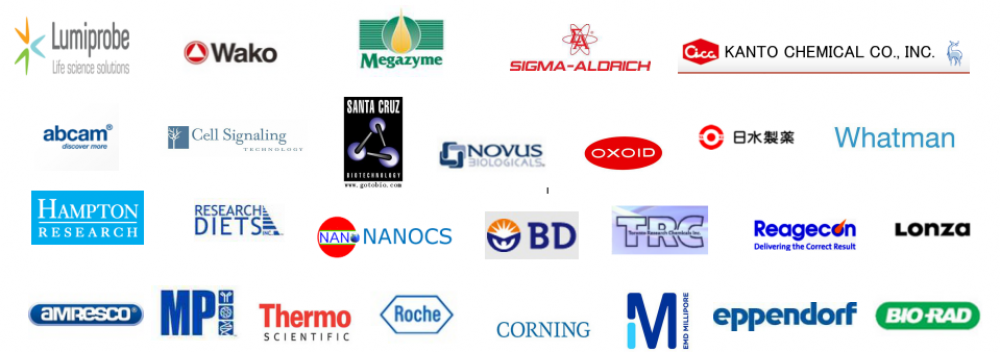德国AppliChem A3778 DNase I 脱氧核糖–上海金畔生物代理
DNase I,即Deoxyribonuclease I,中文名称为脱氧核糖核酸酶I,是一种可以消化单链或双链DNA产生单脱氧核苷酸或单链或双链的寡脱氧核苷酸的核酸内切酶。DNase I水解单链或双链DNA后的产物,5’端为磷酸基团,3’端为羟基。
DNase I活性依赖于钙离子,并能被镁离子或二价锰离子激活。镁离子存在条件下,DNase I可随机剪切双链DNA的任意位点;二价锰离子存在条件下,DNase I可在同一位点剪切DNA双链,形成平末端,或1-2个核苷酸突出的粘末端。
Physical Description: Solid
Product Code: A3778
Product Name: DNase I
Short Description: delivery form: salt-free, freeze-dried powder, chromatographically prepared
Specifications:
Activity (Kunitz): min. 3000 U/mg
Comment:
Deoxyribonuclease I (DNase I) from beef pancreas is an endonuclease (glycoprotein), which preferentially cleaves the phosphodiester bond in the DNA behind pyrimidine nucleotides. This results in a polynucleotide with a 5′-phosphate and a free OH-group in position 3′. DNase I cleaves single-stranded and double-stranded DNA as well as chromatin. The specificity of the enzyme reaction (single-strand-‘Nicks’ versus double-strand breakes) is determined by the ions available. In the presence of Mg2\+ single-strand nicks are generated and in the presence of Mn2\+ double-strand breakes. The pH-optimum of DNase I is 7.8 and it is activated by divalent cations. Maximum activation requires the presence of Mg2\+ and additional Ca2\+. Calcium ions (5 mM) protect DNase I from proteolytic digest. Inhibition is achieved by citrate, if activation is done by magnesium, but not if manganese has been the activator. Besides it is inhibited by chelators such as EDTA and SDS or β-mercaptoethanol.The enzyme is used in molecular biology techniques like digestion of DNA, in the RNA purification (ref. 2 Suppl. 1 pp. 4.1.4) or generating “random nicks” for “nick translation” (ref. 2 Suppl. 9 pp. 3.5.4-6) or ‘footprint’-assays (ref. 2 Suppl. 7 chapter 12.4) or investigations on chromatin (ref. 2 Suppl. 48 chapter 21.4.1).Unit definition\: One unit is defined as that amount of enzyme which causes an increase of absorbance at 260 nm of 0.001 per minute at 25°C based on the method of Kunitz. DNase I is readily soluble in e. g. 0.15 M sodium chloride or in reaction buffer (e. g. 50 mM Tris · Cl, pH 7.5; 10 mM MgCl2 (single-strand ‘nicks’) and 10 mM MnCl2 (double-strand breakes), respecitvely; 50 μg/ml BSA; ref. 2 Suppl. 8 page 3.12.5). For storage dissolve DNase I in 50 % glycerol (w/v); 20 mM Tris · Cl, pH 7.5; 1 mM MgCl2. For stability reasons the concentrations should be at least 1 mg/ml (The maximum solubility is 10 %). This solution is stable for more than one year (ref. 2 Suppl. 8 page 3.12.5). The lyophilized form is stable for 2 – 5 years if kept at \+4°C. If a solution is protease-free, DNase I will not loose significant activity at pH 5 – 7 and 62°C for 5 hours. The enzyme may be heat-inactivated (10 minutes at 99°C).RNase-free DNase I: Dissolve DNase I at 1 mg/ml in 0.1 M iodoacetic acid plus 0.15 M sodium acetate at a final pH of 5.3. The solution is then heated 40 minutes at 55°C and cooled. Finally, 1 M CaCl2 is added to the solution to 5 mM. Store frozen in small aliquots (according to ref. 2 page 3.12.6 Supplement 8).
Bibliography:
(1)Sambrook, J. & Russell, D.W. (2001) Molecular Cloning\: A Laboratory Manual, 3rd Edition. pp. A4.40-42. Cold Spring Harbor Laboratory Press, Cold Spring Harbor, N.Y. (2)Ausubel, F.A., Brent, R., Kingston, R.E., Moore, D.D., Seidman, J.G., Smith, J.A. & Struhl, K. (eds.) 2001. Currrent Protocols in Molecular Biology. John Wiley & Sons, N.Y. (3)McDonald, M.R. (1955) Methods Enzymol. 2, 437-447Deoxyribonucleases (4)Campbell, V.W. & Jackson, D.A. (1980) J. Biol. Chem. 255, 3726-3735The effect of bivalent cations on the mechanism of DNase I. (5)Meinkoth, J. & Wahl, G.M. (1987) Methods Enzymol. 152, 91-94Nick-Translation. (6)Cobianchi, F. & Wilson, S.H. (1987) Methods Enzymol. 152, 94-110Enzymes for modifying and labeling of DNA and RNA.
Storage: -20°C
Origin: from bovine pancreas
产品信息:
| 品牌 | 货号 | 品名 | 规格 |
| AppliChem | A3778,0050 | DNase I | 50mg |
| AppliChem | A3778,0100 | DNase I | 100mg |
| AppliChem | A3778,0500 | DNase I | 500mg |
| AppliChem | A3778_0010 | DNase I | 10mg |
保存温度:-20℃,室温运输。
应用:DNase I 是一种需二价阳离子的脱氧核糖核酸内切酶,可用于降解单链或双链DNA
用于无DNA污染的RNA的制备,逆转录及体外转录等实验。
产品信息:M=~31000g/mol;CAS-NO:9003-98-9
性状:冻干粉
配置方法:溶解在150 mM 5毫克/毫升生理盐水,工作液为无色透明状。
特点:不含RNase(RNase free),可以用于各种RNA样品的处理。
用途:制备不含DNA的RNA样品;RT-PCR反应前RNA样品中去除基因组DNA等可能的DNA污 染;体外T7, T3, SP6等RNA Polymerases催化的RNA转录后去除DNA模板; DNase I footprinting研究DNA-蛋白质相互作用;缺口平移(nick translatioin);产生DNA随机片断文库;细胞凋亡TUNEL检 测中部分剪切基因组DNA作为阳性对照。
来源:牛胰腺纯化得到。
分子量:约31kDa。
活性检测条件:40mM Tris-HCl(pH8.0),10mM MgSO4,1mM CaCl2,1μg of pBR322 DNA。
纯度:不含其它DNA内切酶和外切酶,不含RNA酶。
酶储存溶液:50mM Tris-acetate(pH7.5),10mM CaCl2,50%(v/v)glycerol。
Reaction Buffer(10X):100mM Tris-HCl(pH7.5 at 25℃),25mM MgCl2,1mM CaCl2。
失活或抑制:加入EDTA至终浓度为2.5mM后,65℃加热10分钟可使DNase I失活。酚氯仿抽提也可以使DNase I失活。金属离子螯合剂,达到毫摩尔/升浓度的锌离子,0.1%的SDS,DTT、巯基乙醇等还原 剂,50-100mM以上盐浓度均对DNase I有显著抑制作用。
注意事项:
如需对酶进行稀释,可以用酶储存液(50mM Tris-acetate(pH 7.5),10mM CaCl2,50%(v/v)glycerol)进行稀释。
酶使用时宜存放在冰盒内或冰浴上,使用完毕后宜立即放置于-20℃保存。
为了您的安全和健康,请穿实验服并戴一次性手套操作。
